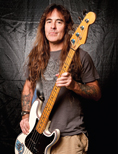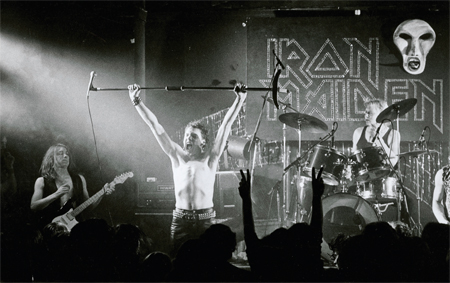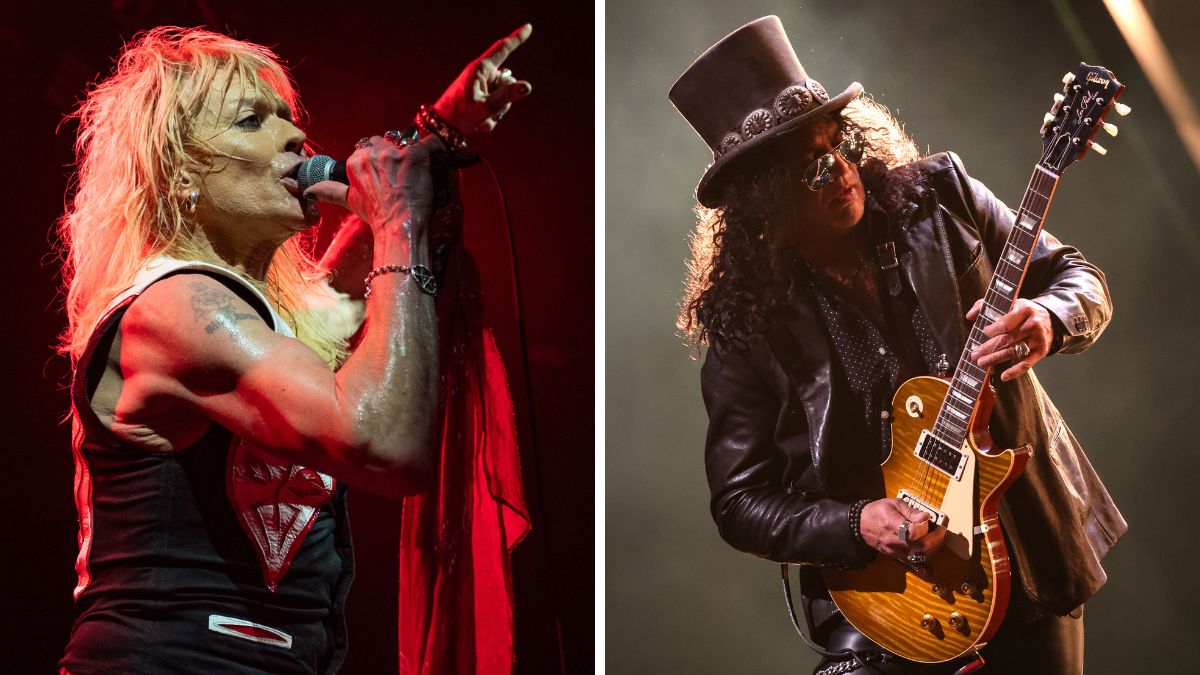Iron Maiden: Maiden Voyage


Originally published in Guitar World, December 2010
When they set off on their career in 1980, Iron Maiden promptly made a
big splash with their self-titled debut album. Dave Murray and Steve
Harris give their account.
Nineteen-eighty saw the release of more classic metal albums than perhaps any other year in music. From AC/DC’s Back in Black to Ozzy Osbourne’s Blizzard of Ozz, Judas Priest’s British Steel to Black Sabbath’s Heaven and Hell, the new decade was ushered in with landmark albums from some of the genre’s biggest names.
Add to this list the self-titled debut from five lads from East London who called themselves Iron Maiden. Though initially lumped in with the then-burgeoning New Wave of British Heavy Metal movement (which included bands like Motörhead, Def Leppard, Saxon and Angel Witch, all of whom also released albums that year), Maiden over the course of the decade rose to become one of the biggest and most successful acts in heavy metal, a position they still hold today, 30 years later. Along the way, the band’s sound influenced generations of newer metal acts, from legends like Metallica to current stars like Avenged Sevenfold.
In 1980, however, Maiden were little more than a struggling young outfit themselves. Formed by bassist and songwriter Steve Harris five years earlier, the band burned through a slew of members before lead guitarist Dave Murray and singer Paul Di’Anno came onboard in the late Seventies, solidifying Maiden’s core early lineup. It was then that the band’s sound—metal riffs and rhythms played with punky speed and aggression, and tempered by twin-guitar harmonies and progressive twists and turns—came into focus.
“I think if anyone wants to understand Maiden’s early thing, in particular the harmony guitars, all they have to do is listen to [British rock band] Wishbone Ash’s Argus album,” Harris says. “Thin Lizzy too, but not as much. And then we wanted to have a bit of a prog thing thrown in as well, because I was really into bands like Genesis and Jethro Tull. So you combine all that with the heavy riffs and the speed, and you’ve got it.”
By 1978, Iron Maiden had built a solid following around London as a result of their energetic shows (which already included an appearance from an embryonic version of their fiendish mascot, Eddie). A four-song demo recorded at the end of that year, and later released as The Soundhouse Tapes, attracted a manager, Rod Smallwood, who subsequently landed the band a deal with EMI. And so, in early 1980, Maiden—which in addition to Harris, Di’Anno and Murray also included coguitarist Dennis Stratton and drummer Clive Burr—entered London’s Kingsway Studios to record their debut album.
Get The Pick Newsletter
All the latest guitar news, interviews, lessons, reviews, deals and more, direct to your inbox!
“We had done The Soundhouse Tapes, but this was a whole new thing,” Murray recalls. “Just the whole experience. You had the amps and the cabinets in there and your headphones on, and it was like, This is it: the big time.”
Adds Harris, “We did the whole thing in 13 days, which was fine. We knew the stuff backwards and forwards because we had been doing it onstage for three or four years before that. So there was no problem there.” According to the bassist, however, there was a problem with their producer, Will Malone. “We were all young and naïve and we didn’t know about producers and what they do—or don’t do, really,” he says. “And [Malone] was just a waste of time. He didn’t do anything. He just sat there with his feet up reading Country Life. So in the end we just bypassed him and dealt straight with the engineer.”
Harris reports that his main instrument for the sessions was a Seventies-era Fender Precision Bass, which he still uses to this day. “Back then it was matte black, but I’ve changed the color over the years,” he says. “And I was likely playing through a Hiwatt amp. I was just trying to get as much top end and presence out of my sound as possible.” In fact, throughout much of the album, Harris’ propulsive and melodic bass lines are pushed far up front in the mix, a sonic trait that has since become one of the band’s calling cards. On Iron Maiden, however, this was somewhat unintentional.
“The truth is that the guitars were mixed too low,” Harris says. “I think the lead sounds are fine, but the rhythms weren’t beefy enough. They sound a bit weedy, really. And I suppose because of that my bass popped out even more than it should have. And from a selfish point of view, yeah, that’s nice, but if you’re considering the overall band sound, it’s not so good.”
For his part, Murray reports that he used his trusty black 1957-era Fender Strat on the recording. The guitar, which had previously belonged to Free’s Paul Kossoff, became Murray’s primary studio and live instrument for much of the Eighties, and it is also the basis for his current Signature Series Stratocaster. “As for amps,” he says, “I was going into Marshall 100 watts. And in between I had an MXR Phase 90, an MXR Distortion+ and a wah pedal.”
Murray recalls that coguitarist Stratton primarily played a Les Paul. “So there was a good balance between us, with the Fender and the Gibson,” he says. “And as far as our parts, we’d sit down and work out harmony bits and stuff. Dennis was quite good. I used to go see him play in bands back in East London and I thought he was stand-out. So it was nice that we got to play together for a bit. And I think there are some great moments on the album.”
Indeed, Iron Maiden is an incredibly strong effort from start to finish. The album features some of the band’s most beloved and enduring songs, including the rampaging opener, “Prowler,” the hooky “Running Free,” the epic “Phantom of the Opera” and the pummeling, twin-guitar-laced “Iron Maiden.” As for his personal favorite, Harris doesn’t hesitate: “ ‘Phantom of the Opera,’ ” he says. “I felt that was probably the first song I’d written that was a bit more proggy. It had a lot of time changes in it and different movements and moods. It was indicative of where I wanted to take things with the band. And looking back on it now, I can see it was really a pivotal point in the direction of our music. I’ve always felt you shouldn’t have to do verse/chorus and that’s it; you should be able to do whatever the hell you want. And that song really proved it.
“But the album is actually rather strong all around. In a way you could argue that it’s a best-of of the first four years of the band. So it’s all gonna stand up, track-wise.”
Preceded by the release of the “Running Free” single, Iron Maiden, replete with cover art that presented a somewhat punked-up rendering of Eddie, was issued in the U.K. on April 14, 1980. (The U.S. version, which hit shelves in August of that year, tacked on the previously single-only release “Sanctuary.”) In what was a surprise to all involved, the album shot straight into the British charts at Number Four. “We thought we’d do reasonably well, because we had a hardcore following up and down the U.K. from playing the clubs for years,” Murray says. “But the fact that it debuted so high was unbelievable for a new band.”
In support of the album, Iron Maiden spent the rest of the year on the road in the U.K., and even opened for Kiss on a string of dates throughout England. By the time the band regrouped at the end of 1980 to begin work on its second album, Killers, Stratton had been sacked. Harris says, “Everyone always uses the term ‘musical differences’ when you’re changing a band member. But with Dennis that was the case. He was a good player, but his influences and the things that he liked and the way he saw things was totally different to where we were heading. We were hoping it wouldn’t be, but it was.”
In his place Maiden recruited Adrian Smith, a childhood friend of Murray’s who had been fronting his own band, Urchin (an outfit which, at one time, included Murray in its ranks). One album later, the band would trade Di’Anno for Bruce “The Air-Raid Siren” Dickinson and begin its ascent to the top of the metal heap in earnest.
And yet, many of the songs from Iron Maiden’s quickly recorded debut continue to be fan favorites, as well as staples of the band’s live show. “ ‘Iron Maiden’ is always in there,” Murray says. “And on this most recent tour we closed every night with ‘Running Free.’ So it shows you these songs have really stood the test of time.”
As for why he believes this to be the case? “The album just captured something,” Murray says. “Listening to it now, 30 years later, it’s still quite interesting. It’s very raw sounding, and for the most part quite uptempo—the songs are almost frantically fast paced. But that was our frame of mind at the time. We were very excitable back then.” He laughs. “Though I suppose we still are.”
“The main acoustic is a $100 Fender – the strings were super-old and dusty. We hate new strings!” Meet Great Grandpa, the unpredictable indie rockers making epic anthems with cheap acoustics – and recording guitars like a Queens of the Stone Age drummer
“You can almost hear the music in your head when looking at these photos”: How legendary photographer Jim Marshall captured the essence of the Grateful Dead and documented the rise of the ultimate jam band
![John Mayer and Bob Weir [left] of Dead & Company photographed against a grey background. Mayer wears a blue overshirt and has his signature Silver Sky on his shoulder. Weir wears grey and a bolo tie.](https://cdn.mos.cms.futurecdn.net/C6niSAybzVCHoYcpJ8ZZgE.jpg)

![A black-and-white action shot of Sergeant Thunderhoof perform live: [from left] Mark Sayer, Dan Flitcroft, Jim Camp and Josh Gallop](https://cdn.mos.cms.futurecdn.net/am3UhJbsxAE239XRRZ8zC8.jpg)







